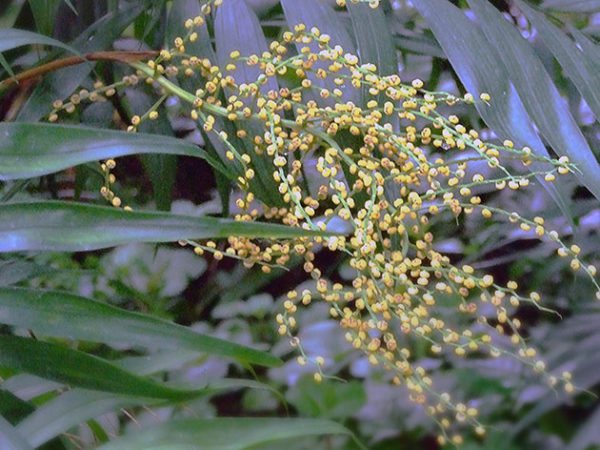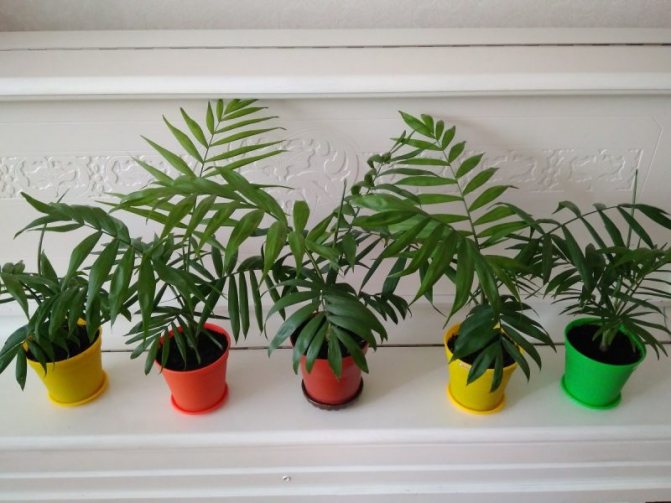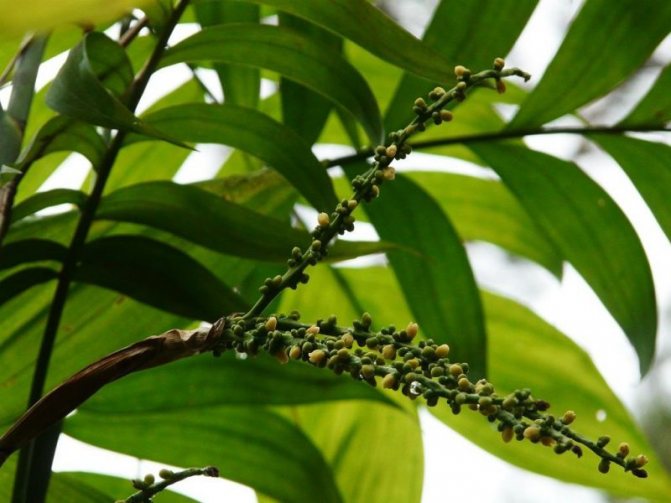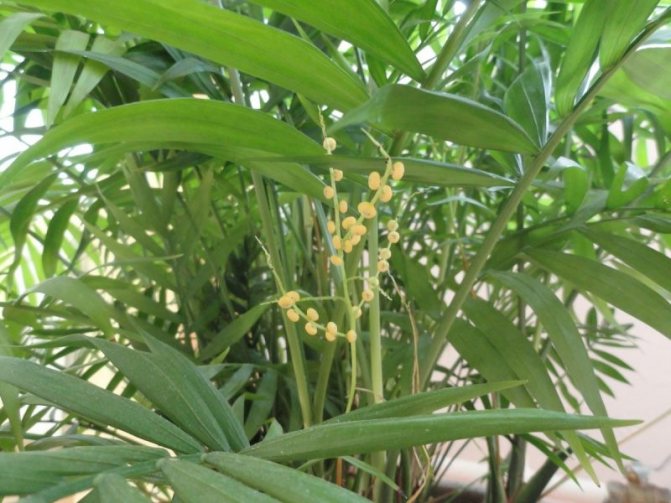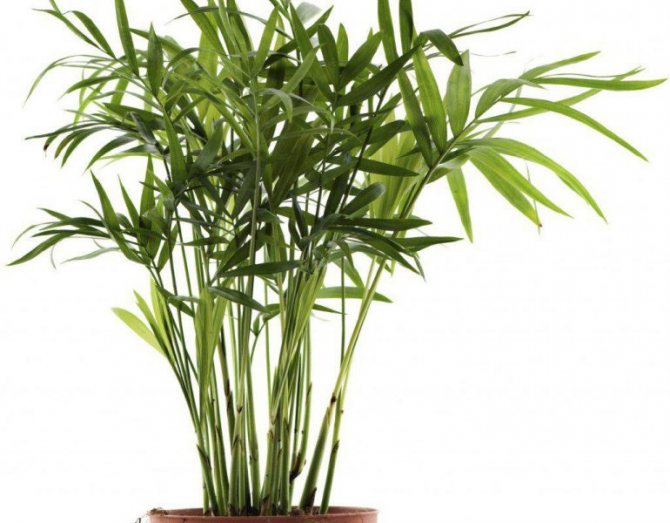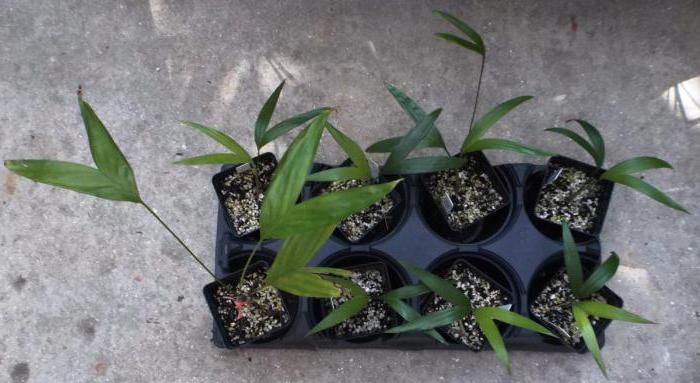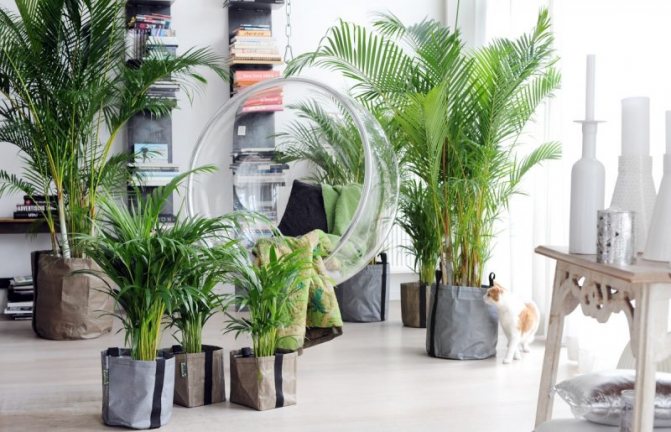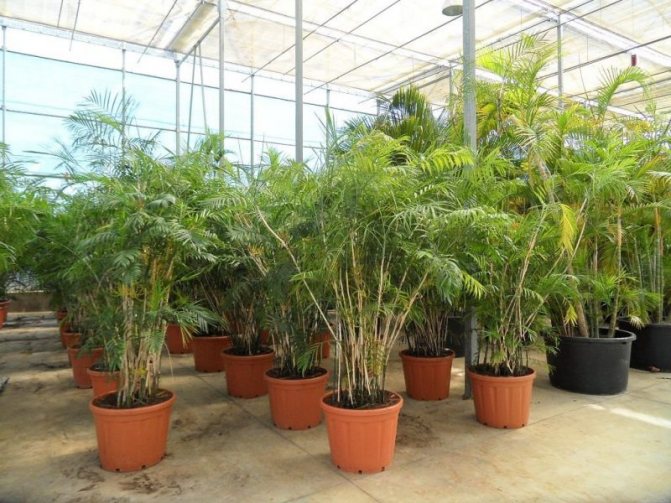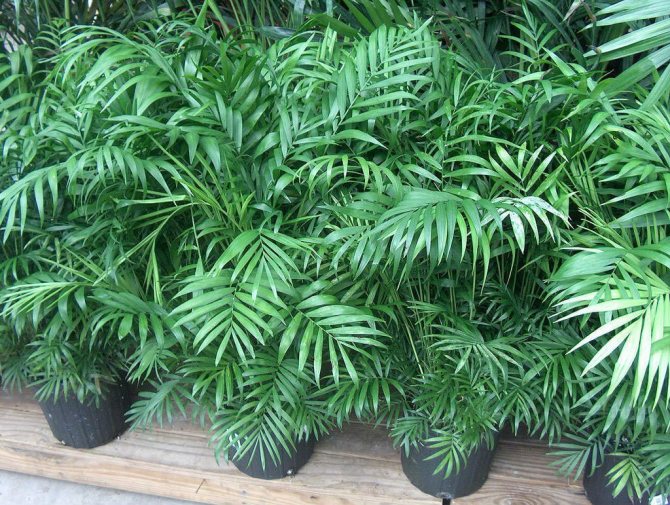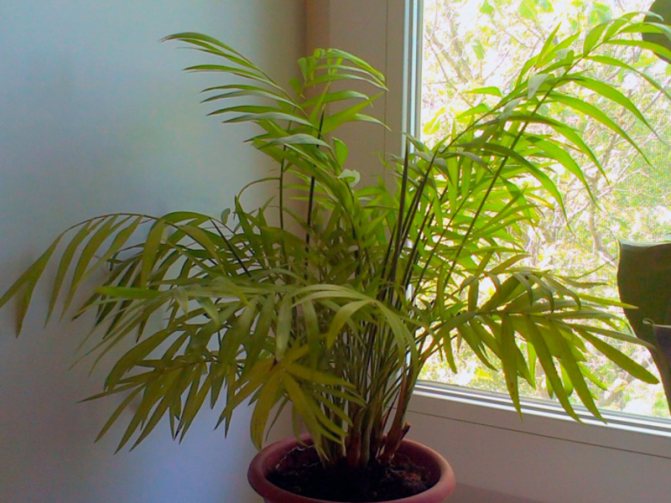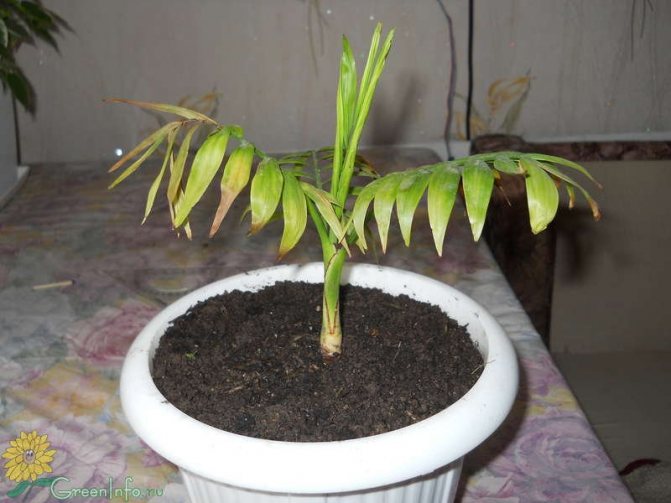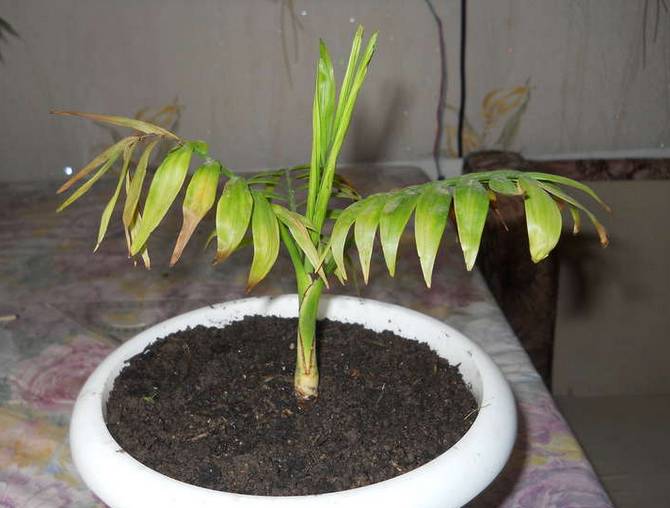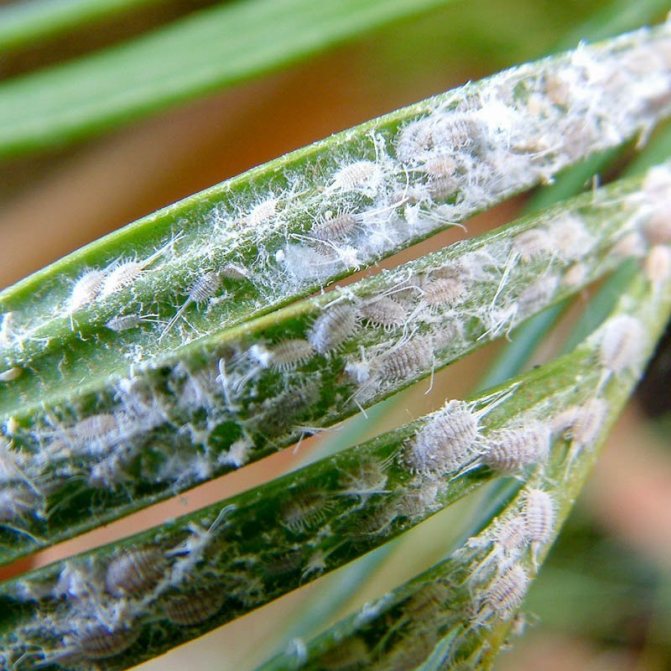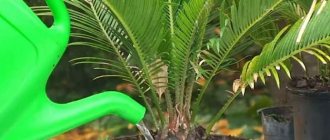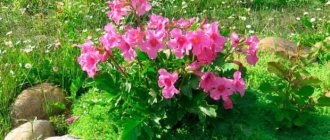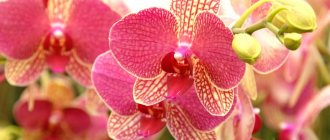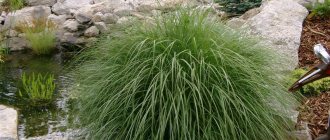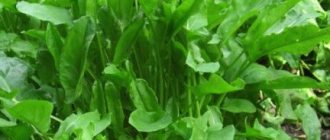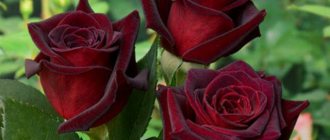Many people like to decorate their apartments and houses with a variety of tropical indoor plants, which have recently become very popular. This exotic look can transform a standard and dull room environment into a true oasis. Hamedorea is considered one of the revered tropical deciduous plants. Among the people, hamedorea is often called a home bamboo palm tree.
Let us consider in more detail the description and photo of this plant, the features of caring for chamedorea at home, as well as the methods of reproduction and the rules of transplantation.
Description of hamedorei elegance
This is a bamboo palm tree. Other names for the plant are hamedorea graceful, neanta graceful, reed palm. In natural conditions, you can meet in Mexico and Guatemala. Grows in tropical forests where there is a lot of moisture. Hamedorea Elegance is grown indoors, but in summer it can be placed on terraces and balconies. It is popular with flower growers due to its compactness. It reaches a height of 2 m, but usually grows up to 1.2 m. It looks like a shrub: many erect shoots come from the creeping trunk. On their tops are placed 6-7 feathery thin leaves, collected in a bunch. The color is dark green. Over the years, the trunk turns dark brown. It grows slowly.
Hamedorea is a blooming dioecious palm that produces separate male and female flowers. Flowering begins at the age of 3-4 years. Inflorescence panicles appear on long peduncles. The flowers are yellow in the shape of a ball with a pleasant aroma. After a while, small peas form in their place. After ripening, they turn black. In the middle of each is a seed. To get fruits, plants of different sexes are planted in one pot.
In addition to its beautiful appearance, the indoor palm is beneficial. It humidifies and purifies the air from formaldehyde and benzene. Safe for children and pets, as it does not belong to poisonous plants.
Basic requirements for growing
In nature, chamedorea grows in the lower tier of the tropical forest. There is little light there, but this does not prevent the plant from developing normally. Competing with large trees for moisture and nutrition, the palm has learned to get by with a small number of them. What she categorically does not tolerate is damage to the root system, so special care must be taken when transplanting.
Interesting: bamboo, houseplant, care
Other popular types of hamedorea
Of the 107 varieties of this palm tree, several of the most common are planted at home:
Hamedorea Bridble
In popularity, it is not inferior to the elegant hamedorea. Has a great similarity. It blooms at a young age. The flower of this plant has a richer hue and aroma, which is the main difference. Plant height reaches 1.5 m.
Hamedorea one-color
The height of the Hamedorea plant is monochromatic, about 1 m. It has several thin stems, at the top of which are feathery leaves. A large bush is formed. The color is light green.
Feels good in indoor conditions. Flowering starts quickly. The flower is light yellow.
Hamedorea metallic
Metallica got its name due to the unusual appearance of the leaves, which have a metallic tint.Plant height up to 2 m. Orange-red flowers form large inflorescences.
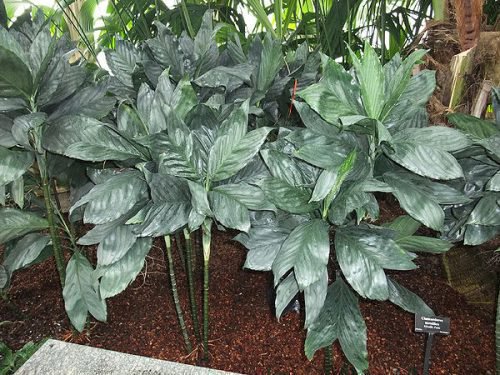
Hamedorea metallic grows up to two meters in height
Related article: Flandre rabbits are considered the oldest breed
Description of the origin of hamedoria
Hamedorea (Latin Chamaedorea), belongs to the Arekov family (monocotyledonous plants). From the Greek language "chamai" - means dwarf, "dorea" - a gift or gift that gives in the form of fruits. These are low-growing shrubs up to 2-3 meters in height, with a woody rhizome and several thin stems. It grows in the foothills of the humid forests of Central and North South America.
In the homeland, most often chamedorea can be found under the slopes of tall trees. This explains their preferred feature of being willing to sit in the shade. Locals use unblown male inflorescences as food for preparing vegetable salads.
The stems of a young plant are like reeds, while adults are like bamboo. Therefore, hamedorea is often called bamboo, reed or mountain palm. Grown for landscaping rooms, decorate greenhouses, winter gardens, used in compositions with other plants.
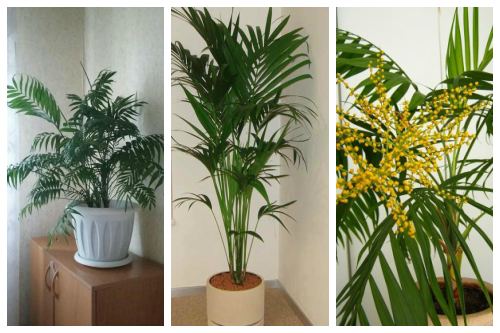

Interesting! According to Eastern teachings, hamedorea contributes to the accumulation of positive energy taken from the environment. Then it easily directs back into space. Therefore, sages and yogis like to meditate next to the plant.
Chamedorea care elegance
In order for a palm tree to feel well at home, it should be provided with the following conditions:
Sufficient illumination
Unlike some types of palm trees, Chamedorea graceful does not need very bright lighting. It can grow by the window, but it also withstands partial shade. Some growers grow the plant under artificial light, which must be turned on for 10-12 hours.
To prevent leaf burns, it is worth protecting the plant from direct sunlight. It is good if the windows in the room do not face south.
Optimum temperature
It is desirable that in warm and cold seasons the temperature in the room where the plant is located is different. In summer, it is necessary to provide + 20-27 ° С, in winter - + 12-16 ° С, then chamedorea will develop well. When ventilating the room, it is necessary to protect the plant from drafts.
Timely watering
Hamedorea elegance should be watered often and abundantly, especially when the room is warm. If it's cool, watering can be reduced to 2-3 times a week. Use settled or filtered water. It should be warm. It is forbidden to allow the soil to completely dry out. Excessive watering is also harmful, in which the roots may begin to rot.
High air humidity
Do not place bamboo palm near radiators when heating is on. She needs high humidity, which is provided in various ways. For this, the plant is sprayed twice a day. A warm shower is helpful. It should be borne in mind that tap water will leave white marks on the leaves. They are cleaned with a damp sponge to remove dust. Artificial fountains and aquariums provide additional moisture. Humidifying devices can be used.
Top dressing
Fertilization contributes to the rapid development of the plant, because then it receives all the useful substances from the soil. They are fed with liquid fertilizers for palm trees or for ornamental deciduous plants. The amount is determined according to the instructions. When using the second fertilizer, you only need to take half the dose. Apply every two weeks from April to September. You can buy complex preparations with a high nitrogen content. Thanks to him, the plant grows green mass.
Transfer
Also, caring for the graceful chamedorea provides for its transplant: once a year, young plants, once every 3-4 years, adults.You can replant as needed if the palm has formed many roots and they come out of the holes in the bottom. In this case, the pot is taken more than the previous one. For drainage, broken brick and expanded clay are laid on the bottom. The soil mixture is prepared as follows:
- 3 parts of sod land;
- 1 part hardwood;
- 1 part river sand;
- 1 part peat.
You can buy a special palm plant mix and add some charcoal to it. The dry tips of the leaves are cut off. If the whole is dry, it is removed.
There is no need to trim the top. This will have a bad effect on the plant: it will stop growing and die. The natural process is when the lower leaves dry up and die off. They leave a ring-shaped trail with dry films.
Problems with hamedorea
- Yellowed leaves. With this problem, you should pay attention to 3 points: insufficient watering, low humidity in the room and an unnecessarily low air temperature.
- Dry leaves. This problem has 2 reasons: too cold and too little moisture in the air. It must be corrected, otherwise the plant will wither.
- Rotting roots. Excessive watering and cooling can lead to root rot. Transplant by draining and warm the palm.
- The dying off of the lower leaves is a natural process. You don't need to pay attention to it. It is only necessary to remove the dried parts of the plant during the pruning process, closer to the trunk.
- Drying of leaves - excessively dry air in the room.
- Small brownish spots on the leaves indicate that the palm is watered in the sun.
- Drying cones of leaves indicate excessive watering.
Hamedorea is a plant with which a folk omen is associated - if the plant is brought into the house, then trouble will happen. To believe or not to believe in omens is the business of every person. But in order to protect themselves from this misfortune, people simply bring a pot in a chamedorea flower into their house and everything is in order, the trouble bypasses the house.
Therefore, to the question of whether it is possible to keep chamedorea at home and whether it is worth paying attention to the signs, the answer is one - you can!
Reproduction at home
To grow a new palm tree, you can sow its seeds. Also propagate by root layers or simply divide the bush.
- The sowing method is difficult and long. Seeds are soaked in warm water for 5 days before planting. Their shell is sawed off because it is very hard. A mixture of peat and sand is prepared. The seeds are deepened into it by 1 cm. Germinated at a temperature of 28-30 ° C. To provide it, you can make heating from below. In a few months (even up to six months), seedlings will sprout. They are transplanted when their leaf becomes 8-10 cm in size.
- When propagating by layering, young shoots are taken, which have formed their roots and are separated from the main plant. Sometimes it is possible to divide a whole bush, but at home this is done extremely rarely, because the creeping trunk does not grow to a length that will be sufficient for division. In the store, palm trees are not sold single, but by bushes that can be separated.
Related article: Review of the black suit of horses
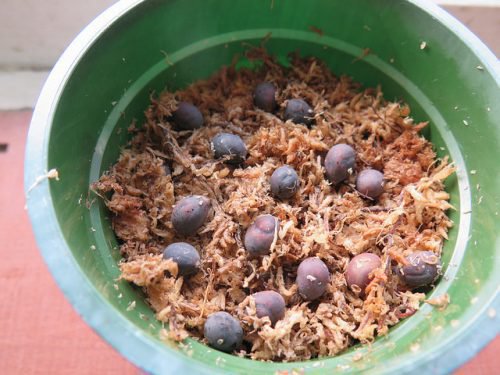

Reproduction of chamedorea by seeds is a laborious process
How to properly care for a mountain palm tree
Hamedorea does not require increased attention to itself. Home care is carried out in accordance with agrotechnical requirements.
For your information! In 1980, NASA conducted research. Scientists have proven that indoor chamedorrhea is able to purify the air from benzene, formaldehyde, trichlorethylene and other harmful compounds. Air purification efficiency was found to be one of the highest among indoor plants participating in the study.
Temperature and lighting
Palm tree - does not tolerate direct exposure to sunlight, but loves diffused light. Therefore, it is better to place it in large pots on the west or east side of the window, with the obligatory access of fresh air.Cold drafts should not be allowed.


Hamedorea easily tolerates temperature changes, it should not be allowed to drop from the norm of 12 ° C. In winter, it will feel normal at 16-18 ° C, in summer - 20-28 ° C.
Soil, feeding and watering the reed palm
- The composition of the soil affects the success of growing hamedorea in indoor conditions. You need to take in equal parts: humus, sand, turf and peat. You can buy ready-made potting soil from your flower shop. The palm tree prefers tight pots. Therefore, it is better not to take bulk containers for a young culture. Before planting, good drainage lays down on the bottom, then the finished soil.
- It is necessary to feed the plant during the period of active growth, that is, from spring to autumn. 2 times a month, a complex fertilizer (preferably in granules) or a special fertilizer for palm trees is applied to the ground.
- Watering chamedorea should be guided by the top layer of the earth: more often in summer, as it dries, in winter it is enough - once a week. Better "not to top up" than to pour - say the professionals.
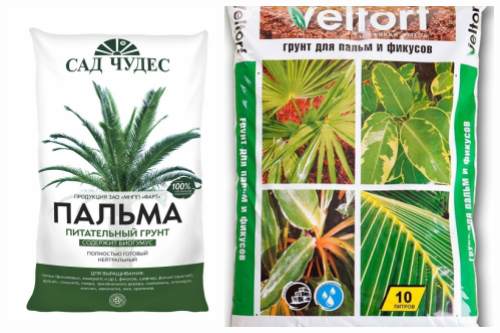

Important! Hamedorea loves humid warm air, so in summer it is necessary to spray the plant several times a day.
Transfer
Some florists have different opinions on this issue. More experienced ones recommend replanting a palm tree if necessary, others - every three years.
It may be necessary when a young palm tree is actively developing and going into growth. This is typical of young cultures.
In case of plant disease or the spread of pests, you also need to change the planting container. The best time for this procedure is the beginning of spring, when the plant has not yet gone into active growth.


Diseases and pests
The plant begins to hurt due to improper care. Unmoistened room air causes the tips of the leaves to dry out. If they turn yellow entirely, the plant suffers from chlorosis. It is worth using other types of fertilizers, because such an effect on the palm gives an excess of calcium. With sharp jumps in temperature, the leaves darken and fall off. In winter, care must be taken that the palm does not touch the window.
Excessive watering will be harmful to hamedorea, in which mold develops and roots rot. A specific smell then emanates from the soil.
Among the pests that infect the bamboo palm, the spider mite should be noted. It is determined by the cobweb that forms on the leaves on the back. You can also see yellow spots on them. Over time, they increase, darken, and the leaf dies off. Not so often, worms, aphids, scale insects, etc. infest the plant. For pest control, spraying (leaves on both sides), a warm shower, and wiping with soapy water are used. If such methods do not work, they are processed with an actelik.
Hamedorea elegans is subject to fungal diseases, in which the roots rot and the leaves die off. To overcome them, fungicides are used.
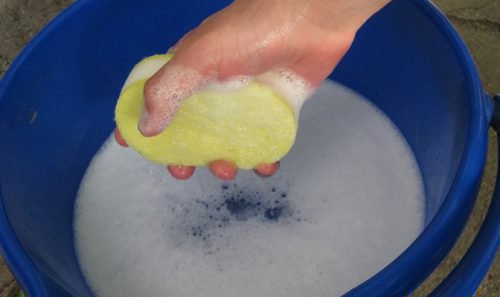

Soapy water will help get rid of most pests.
Why does chamedorea dry, leaves turn yellow?
The cause of the painful condition of the plant is improper care. If the leaves turn yellow after transplanting, this is a temporary phenomenon. The lower leaves of a palm tree turn yellow and die off - a natural process of changing the leaf apparatus.
If the leaves dry massively - the air has low humidity, if only the tips dry out - you need to reduce watering. The same measures are taken if the plant looks lethargic, and the leaves turn black and die off. It is useful to check the roots for rot.
Dry brown spots - traces of sunburn, you need to adjust the illumination.
The palm is very fond of cats. The plant is protected by sprinkling with lemon juice. You can put a few lemon peels in the pot, which change over time.
Varieties of hamedorei
As already noted, more than 100 different hamedorei are found in the natural environment, but we will talk about the most popular and common ones:
- Graceful
This bamboo palm tree, which grows up to 2 meters in height, has spectacular variegated leaves, and the trunk diameter can reach 3 meters. There are few trunks, each has no more than 10 pairs of leaves. This is an excellent home option and blooms in captivity, covered with yellow panicles of inflorescences. During fruiting, small black berries form on it.


Graceful
- High
This is a bushy palm tree, which grows a new trunk every year, in nature reaching 5 meters in height. Outwardly, its trunks are similar to bamboo stems, they are often thin and graceful, with well-visible fallen old leaves.
Each trunk has no more than 6 pinnate, arched leaves, elongated, lanceolate. The flowering of high chamedorea begins with the formation of bright orange buds, from which small flowers appear, forming panicles.
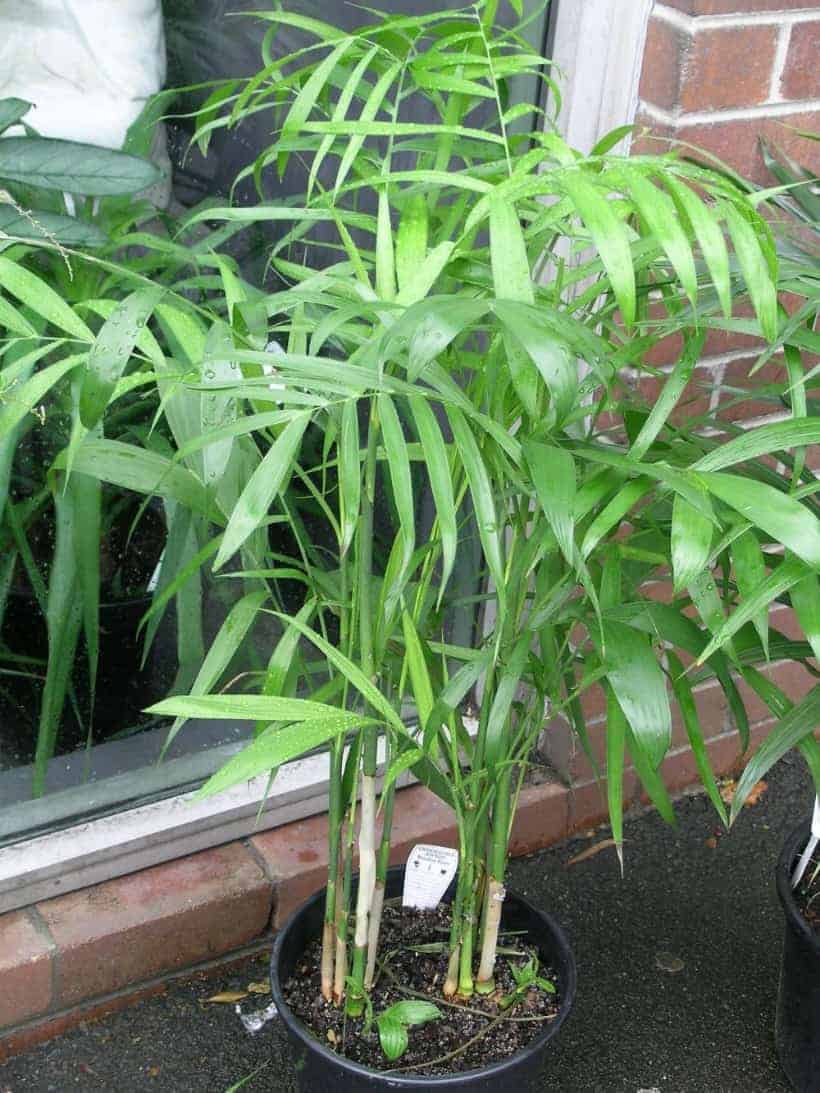

High
- Ernest-August
A rare chamedorea, in which root processes are formed in the nodes of a single stem. The main feature of this palm is the integrity of the leaf plates, they are not divided into lobes and have a pointed oval shape. The leaves are painted in a dark green color, at the tip they bifurcate a little. Unlike most Hamedorei, Ernest-Augusta's flowers are bright red.


Ernest-August
- Metal
Its leaves are similar in structure to the leaf blade of the palm of the previous variety. They are leathery, widened, and wrinkles often appear on their surface. The plant has one trunk, over time it is able to thicken and grow stiff.
The palm tree is low, the height varies from 1 to 2 meters. Unlike most relatives, it feels good in the shade or partial shade. Metallic chamedorea is suitable for growing in low light, for example, indoors with small windows.
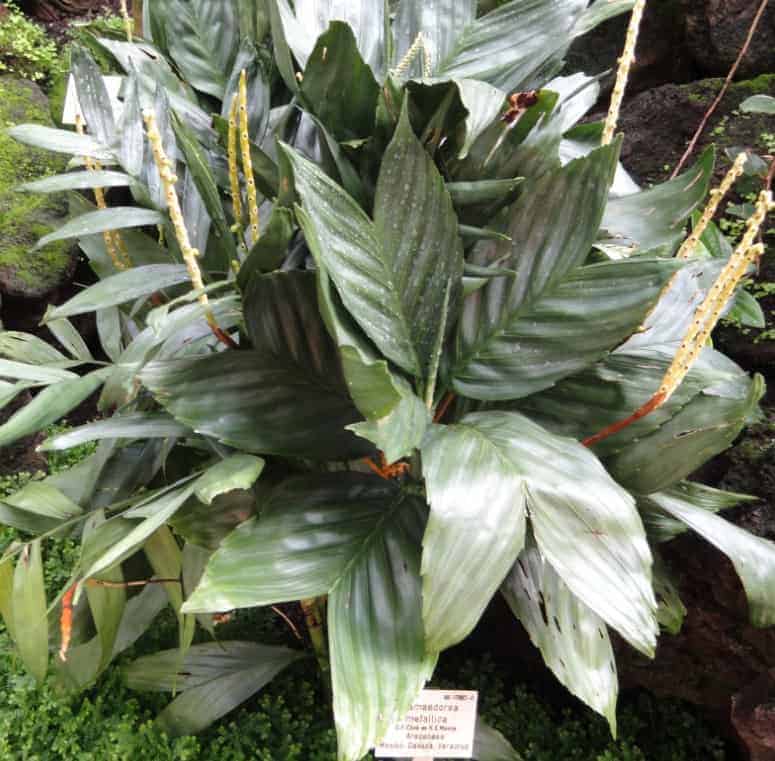

Metal
- Seyfritz
Another bushy bamboo palm, with many shoots covered with leafy, spreading plates. The most light-loving variety of chamedorea, which is best placed in a bright room with large windows.
Indoor bamboo palm tree can become a real decoration of the interior, you just need to know how to properly care for it.
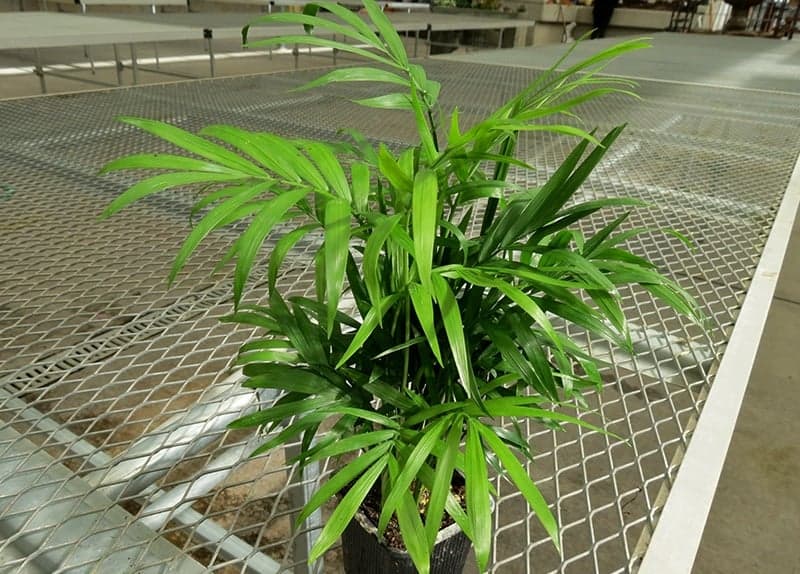

Seyfritz
Reproduction of the Hamedorei palm
Mountain palm has excellent vegetative and seed propagation.
- Vegetative propagation takes place through the root processes. You can separate it when you already have your own formed roots.
- Palm seeds can be purchased at a garden store and planted immediately in prepared soil. To accelerate the germination of seeds, they create a greenhouse effect - after sowing, they slightly moisten the soil and cover with a film. The temperature should be kept at 25-28 ° C with a ventilation condition for 5-10 minutes. Then the sprouts are planted in 3-4 pieces per pot, for better confidence that the plant will take root.
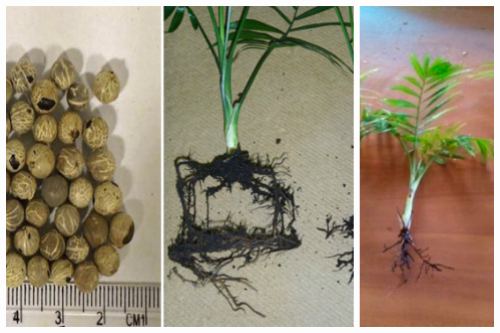

Advice! After buying seeds, you need to immediately start sowing chamedorea, as their germination is lost over time.
Choosing the right hamedorea when buying
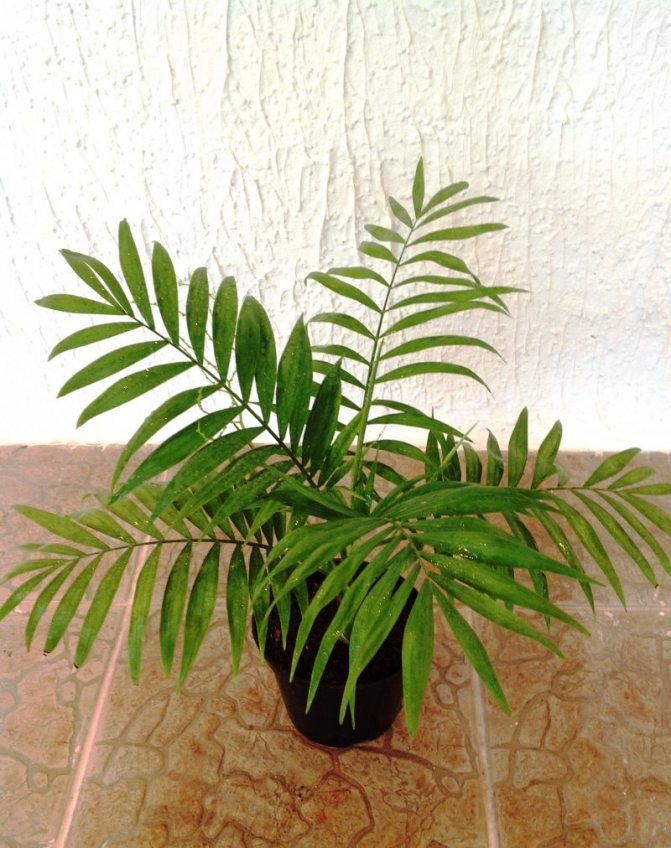

When buying a plant, so as not to think later why chamedorea dries, you must be very responsible in choosing your future pet.
Examine the plant carefully for damage: if it has broken branches, improperly formed, twisted, dull or yellow leaves, then it is better to refuse to buy such a specimen right away. Despite its unpretentiousness, chamedorea very often suffers from root rot, and the yellow leaves and stunted appearance of the plant are just more than eloquent confirmation that it is infected with phytoinfection.
In addition, when buying a palm tree, be sure to inspect it for infestation by insect pests. If you notice tiny greenish or brown dots on the leaves or trunk of the plant, then when purchasing such a specimen, be prepared for the fact that you will have to fight the ubiquitous spider mite.
Bush formation
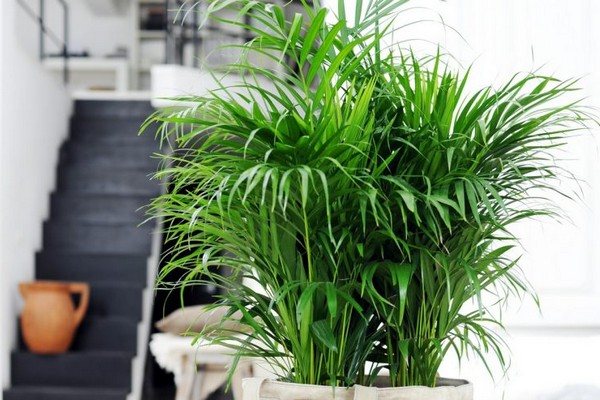

To make a tropical palm tree look aesthetically pleasing in your home, you need to constantly pick off old, dried yellow leaves. They are removed with scissors, without waiting for their complete withering away. You should also remove immediately the flowers that have begun to form, since they still will not be beautiful in indoor growing conditions, but they will take a lot of energy from the palm tree.
What conditions to create for successful cultivation
Hamedorea is absolutely not capricious and objectionable.
they are draining, but, like all houseplants, it will respond to care and creation of comfortable conditions with rich green color, cheerful appearance and excellent development. This plant will surely test your nerves for strength, because it is quite slow, and therefore it is unlikely to please you with an active pace of development, rapid growth and large size. The healthy appearance of such a pet will be an excellent reward for the care and proper care of the plant.
Lighting
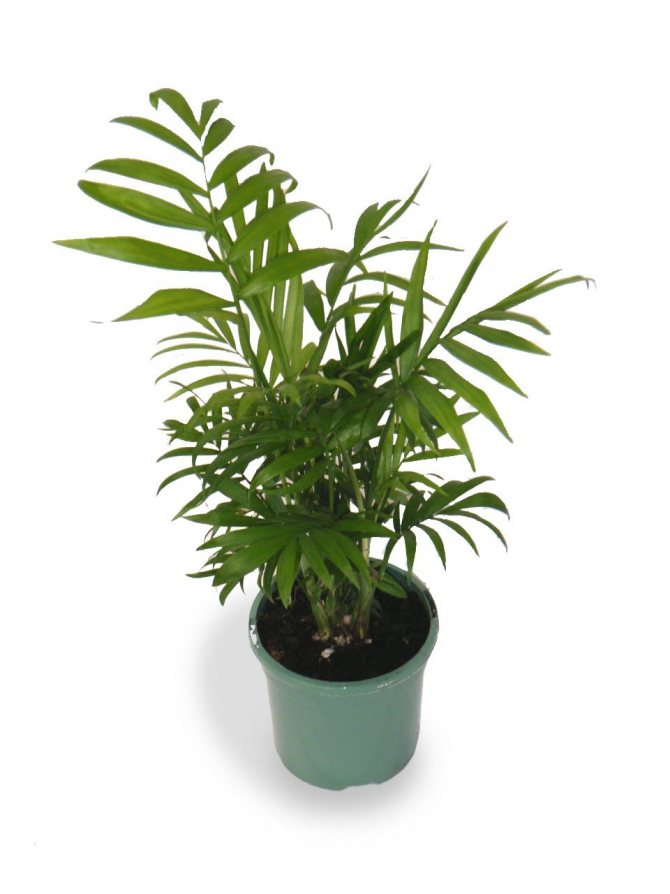

When choosing a place for chamedorea, it should be remembered that it is very sensitive to direct sunlight, but at the same time it perfectly tolerates shade and even a significant lack of light.
The thing is that at home it grows in the shade of taller trees, and this makes it ideal for cultivation in home greenhouses and small apartments, characterized by poor natural light.
Therefore, the main task of the grower — choose a place for the plant in the north or west side of the room, where it will be reliably protected from the sun's rays, especially since it can be quite content with only artificial light.
If there is no other place, then the palm tree will feel great in the back of the room, away from windows, which greatly simplifies its cultivation and makes it attractive for novice growers.
Temperature
Like all palm trees, chamedorea loves a warm, but not hot climate.
Therefore, if you can provide the plant with a temperature in summer from + 22 ° C to + 25 ° C, and in winter from + 16 ° C to + 18 ° C, then you will be surprised by the rich emerald color of its leaves and relatively fast growth rates. The plant does not tolerate extreme conditions, which means that a temperature drop below + 10 ° C will be critical for it and can lead to death.
Frequently asked questions about growing hamedorea
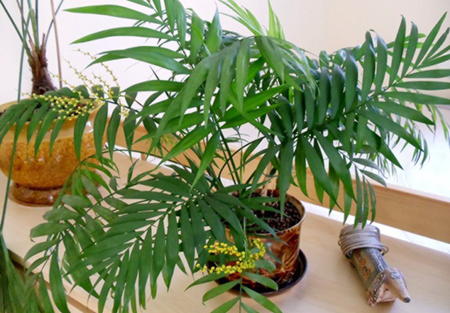

Leaves turn yellow. Why?
Even with diligent care, the leaves of the flower periodically turn yellow. Take your time to trim them if there is still a lot of green on them. One of the reasons can contribute to the yellowing of vegetation:
- Wrong location,
- Plant age,
- Diseases
- Damage by pests.
Leaves turn yellow with age. They need to be cut close to the stem, leaving a small petiole, which will then dry completely. During handling, these petioles are carefully cleaned, and the palm looks fresh again.
The diseases and pests discussed above can be the cause of the appearance of yellow leaves.
An improperly chosen location also leads to yellowing of the foliage, especially if the plant is located in a zone of direct rays. It is not the flower itself that overheats in the sun, but the container and with it - the substrate and roots.
Drying of the tips of the leaves
Sometimes the tips of the flower leaves dry out. What are the reasons for this?
- Insufficient watering
- Dry air
- Flooded soil, rotten roots (dryness of young foliage appears, leaf tips dry out);
- Too dense substrate that retains moisture for a long time. In this case, the roots are constantly in a moist environment.
Observing agricultural techniques and rules for caring for a palm tree, it is not difficult to eliminate these manifestations.
White bloom, drying tips, blackening petioles - problems and solutions
Some of the problems that appear on a palm tree are not directly related to the plant, but to the soil in which it grows.
Table: Ground Problems
| Problems | Symptoms | Necessary measures |
| Stopping growth | Weak or absent growth | The soil temperature should be maintained at +25 degrees, because at a lower temperature, the activity of the root system slows down and the absorption of nutrients from the soil decreases. |
| Lack of nutrients | Chlorosis (fading) of leaves |
|
| Leaf burn | Brown spots along the edge of the leaf plate | Replacement of the soil is required (complete or partial), watering is reduced in parallel, since the edge burn of the leaf occurs due to excessive dampness and poor aeration of the roots. |
| Magnesium deficiency | Lower leaves brighten (chlorosis) |
|
| Copper toxicity | Elliptical spots on the leaves |
|
Also, the loss of attractiveness can be caused by mistakes in care and maintenance.
Table: yellowing leaves and other consequences of improper maintenance conditions or care errors
| Problem | Possible reasons | How to fix the situation |
| Brown spots on the leaf blades |
|
|
| The tips of the leaf blades dry out | Too hot and dry indoors. This happens especially often during the heating season. |
|
| Leaf blades gradually turn yellow |
|
|
| The lower leaves dry up | This is a natural process caused by the age of hamedorea. | Aging can be delayed if the plant is sprayed more often. |
| Leaves become darker in color and wither | Room temperature too low | Move the hamedorea to a warmer place |
Treatment of palm trees from diseases and pests
Under good conditions and with the correct watering regime, chamedorea is practically not affected by pests and diseases, but with excessive moisture or dryness, it can be annoyed by shield aphids, spider mites, mealybugs; in dampness, the palm tree can get sick with root rot.
Table: how to treat a palm tree from lesions
| Diseases and pests | Signs | Reason for appearance | Treatment and prevention measures |
| Root rot |
| Cold indoor air and too much watering |
|
| Fusarium wilting |
| The room is too humid |
|
| Mealybug | A cotton-like spider web appears on the leaves. | The air in the apartment is too dry, the plant does not have enough moisture |
|
| Spider mite |
| Stable dry indoor air |
|
| Shield aphid (scale insect) |
| Not enough humid air |
|
Photo gallery: hamedorea diseases and pests
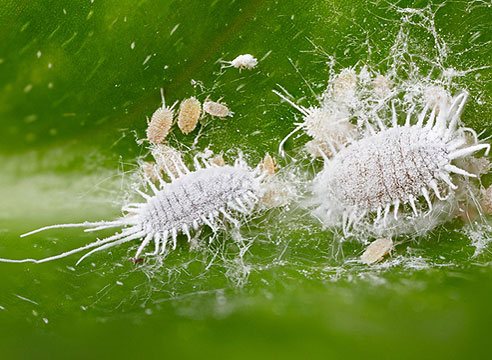

A sign of mealybug infestation is a cotton-like bloom on the leaves


Spider mites appear on hamedorea due to dry indoor air


Due to the activity of the shield aphid, the leaves turn pale, become lethargic.
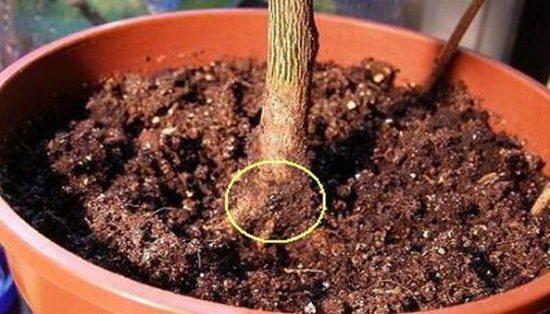

Root rot is indicated by black spots on roots and shoots.
Should you grow chamedorea?
The bamboo palm removes carbon dioxide from the air in the house, filling the premises with oxygen. This is a real find for people living in apartments with windows overlooking the highway, since it is able to neutralize poisonous substances (trichlorethylene, benzene) that get into the air from exhaust gases.
The aesthetic factor must also be taken into account. The bamboo palm tree with its exotic look will perfectly complement any interior, decorate your apartment, add extravagance to it. And if we consider that some varieties emit a pleasant aroma during the flowering period, then the presence of this plant in the house becomes fully justified.
We have already mentioned that caring for chamedorea is quite simple. Therefore, beginner growers can also grow this plant. It is enough just to follow the simple rules of growing chamedorea, and it will respond to your concern, demonstrating its excellent health and beautiful flowering.
Transplant rules
The bamboo palm is a plant that does not like any outside interference. The transplant is very stressful for hamedorea and should be done no more than once every three to four years. Please note that the need for transplanting is not associated with an increase in the size of the palm itself. In this case, it is enough to pour the earthen mixture into the pot annually. The reason for replacing it with a larger one should be the complete filling of the container with roots.
If the chamedorea is planted too tightly and visually looks quite voluminous, it can be divided into two or three groups, planted in several pots.
Experienced flower growers do not recommend replanting chamedorea immediately after purchase; first, it needs to settle down in a new environment. After a two-week adaptation period, the palm tree, which is very susceptible to bare roots, is transplanted by the transshipment method. Pre-moisten the soil in the transport pot so that the plant can be removed without difficulty. For a successful transshipment, follow five guidelines:
- fill the bottom of the new pot with drainage - to a height of 5 cm, and then add sterilized soil by about 10 cm;
- carefully remove the chamedorea from the pot - it is important not to destroy the lump with roots;
- cut off the roots with a sharp knife - you need to cut off rolled, thin roots that look like felt;
- place a palm tree in a pot - fill the free space with soil, compact;
- water the freshly transplanted chamedorea with water at room temperature, and protect it from the midday sun for a couple of weeks by organizing moderate watering.
Photo of a plant and its flowers
Take a look at the photo of how a bamboo palm usually looks.
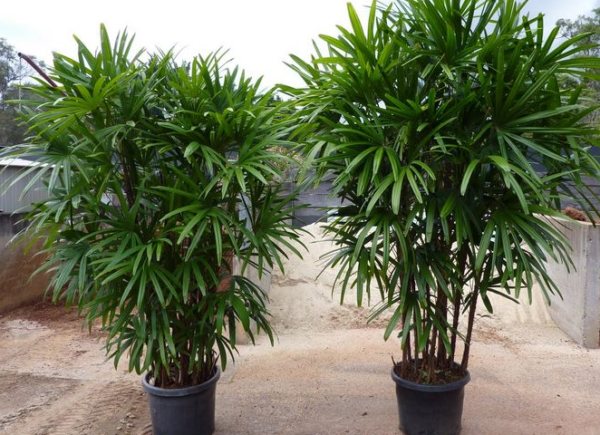

And also a photo of a blooming hamedorea.
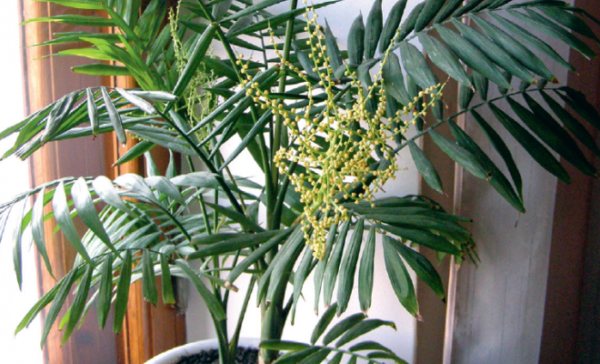

In this photo, you can take a closer look at her flowers.
